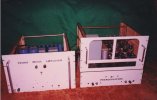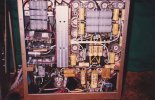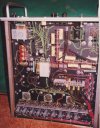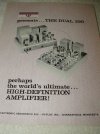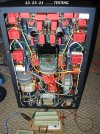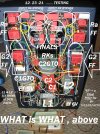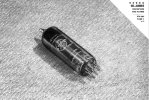12- 26 -2021 ........................... INITIAL LISTENING IMPRESSION .......................... and WHY
We have not visited my Audio Mentor, over the last 2.5 years, to hear his very latest SE DC amps, (eg : 6E6P-DRU DCed to a KT150 ) which I am willing to bet.... are fabulous sounding.
However, over the last two days, our SE DC amp has been playing music, breaking in, and we thought it apropos, to share a subjective listening initial impression.
This amp is showing signs of being the best tube amp we have ever built or ever heard.
Compared to our 2019 SE build ( 1/2 12BZ7 DCed into a KT88 ) ( and ALL other amps we have personally heard ), this initially seems to play music with about 12 to 18 percent more definition, or audio resolution. In dynamic terms, it seems to excel by 10 to 15 % over all else - we have ever heard. Speakers used for this evaluation are very-well-set-up ALTEC Voice of the Theatre A7-8s, with top-of-the-line ALTEC 515B woofers and ALTEC 802D compression drivers.
This highly positive sonic 2021 result was planned for........................... and is not totally surprising to us .
AS we often repeated in this thread ..........." In the end, we all listen to a modulated power supply. How good is it ?? "
In the first three pages of this thread, ( if one takes the time, and has the actual interest to read this ), we described our preference of a unique passive power supply over any active regulated supply. We are much in favor of the actual listening results with OUR passive build approach. Also we described in this thread the ( largely unrealized ) need and reasons for using multiple film cap bypassing, in all key circuit locations.
- - - - - - - - - - - - - - - - - - - - - - - - - - - - - - - - - - - - - - - - - - - - - -
Here is why we feel this 2021 effort ( 6005 amp ) is playing better, right off the bat, than the 2019 ( KT88 amp ) effort :
Realize, both amps are similarly built with 1/2 a triode, directly connected to a TETRODE, and operating with ZERO negative feedback :
.
KT88's G2 power supply : One B+ SHUNT and one Final Filter ( L1/C1 ) .
6005's G2 power supply : Two B+ SHUNTS, in series, and two Final Filters in series ( L1/C1/L2/C2 ).
KT88s Ra power supply ( Input tube's plate resistor = "Ra" ) : ......................................
.......................................................Two B+ SHUNTS, in series, and one Final Filter ( L1/C1 ).
6005's Ra power supply : Two B+ SHUNTS , in series, and two Final Filters in series ( L1/C1/L2/C2 ).
So, the new 2021 design, for Ra AND G2, has become Double SHUNTED and Double Final Filtered !
From what has been heard, from reference - familiar source material the last two days, we feel it was well worth the effort !!
Kindly realize this, ( and except for amps by our Mentor, Dennis Fraker of Serious Stereo ) no amps to our knowledge, ( in ALL of the tube audio amps ever made in this world ), use B+ SHUNTING, and / or B+ FINAL Filters !!! ZERO, let alone one, or better yet, two in series !!
Whoops, we do know of one notable exception. In a lovely place in this world called Thane, India. Hari Iyer's self-built 2020 KT88 amp, is an offshoot of our 2019 design.
- - - - - - - - - - - - - - - - - - - - - - - - - - - - - - - - - - - - - - - - - - -
Other initial comments :
1) Measured circuit voltages match, very much as planned, conservative.
2) Thermal operation is decent, no hot spots on chassis
3) So far, NO ( multiple ) power transformer PHASE orientation-work has been done. We will do it by ear, is important.
4) It takes about 75 hours, for the 6 Ohm chokes to break - in, and lose their midrange recessiveness.
5) It takes time, for the film caps, solder joints, rectifier tubes etc. to break in.
6) This amp, with a new-found level of resolution and dynamics, is actually EXCITING to hear.
Thanks everyone, for following along. Need next, to show some " top side " photos. OHH...............
7) The Softone RW-20 transformers sound much better, with their metal covers removed, as do all outputs. No contest on any really good hi fi system.
Jeff


